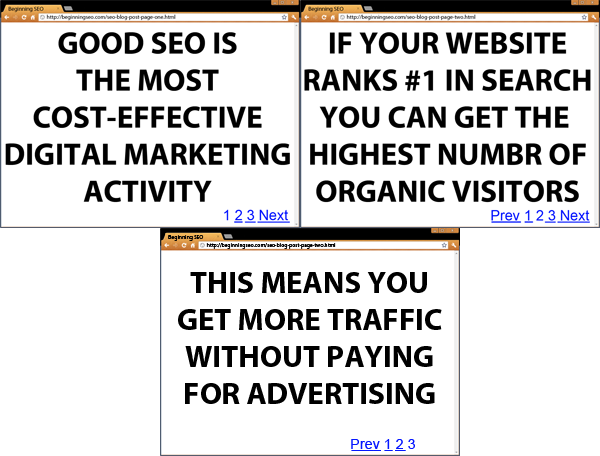While you’re learning SEO you run into questions that seem to have a simple and straightforward answer. Once you dive in however, you can sometimes realize that the answer only raises more questions. So is the case with pagination using Rel=Prev/Next. Nearly every website needs to break up some sections and pages somehow. Whether it be blog pages, category listings or products in an eCommerce catalog, there are times when there is more information than you would like to have on one page. Google has let us in on a way that we can tell search engines that we have intentionally broken up our content into multiple pages by labeling pagination with rel=next” and rel=“prev”.
Using rel=prev and rel=next is very simple. When you split content into multiple pages all you need to do is create <link> tags within the <head></head> of each page that tell the search robot what came before, and what comes next. For example, if I wanted to paginate a SEO blog post on three pages on this website, the series of pages would contain the following tags.
- /seo-blog-post-page-one.html
- <link rel=”next” href=http://serptwerker.com/seo-blog-page-two.html”>
- /seo-blog-post-page-two.html
- link rel=”prev” href=http://serptwerker.com/seo-blog-page-one.html”
- link rel=”next” href=http://serptwerker.com/seo-blog-page-three.html”
- /seo-blog-post-page-three.html
- <link rel=”prev” href=http://serptwerker.com/seo-blog-page-two.html”>

Easy, right?
Sometimes a webmaster will give you the option to see all of the information on one page. If you have all of the information on one page, and the same information broken into three additional pages, shouldn’t you be concerned with duplicate content?
If you would like to include a View-All in search results you have a couple of different options, depending on how you want Google to handle it.
When I’m shopping online the first thing I usually do is click the View All link, so I don’t have to reload the page a bunch of times. For some reason I don’t like visiting a product page that isn’t paginated first though. Maybe I would rather know that the website has a footer before I start looking around, who knows. To please a user like me I wouldn’t do anything beyond adding rel=“next” and rel=“prev” in the <head>. This will help Google understand that I prefer to place more search value on the numbered pages then on the View All page.
If I would like to Google to consider the View All as important, I would create <link> tags within the <head></head> of each numbered page that tell the search robot that the View All URL is rel=canonical. For example, if I wanted to paginate a SEO blog post on three pages on this website, the series of pages would contain the following tags.
- /seo-blog-post-page-one.html
- <link rel=”canonical” href=http://serptwerker.com/seo-blog-view-all.html”>
- /seo-blog-post-page-two.html
- <link rel=”canonical” href=http://serptwerker.com/seo-blog–view-all.html”>
- /seo-blog-post-page-three.html
- <link rel=”canonical” href=http://serptwerker.com/seo-blog-view-all.html”>
Even easier, right?
If you’re still confused, please watch Maile Ohye break it down:
When I learn how to use a new tool, I like seeing what happens when you do things with it that aren’t written about in the instructions. I learned from this Webmaster Central forum post that you can add rel=canonical to the different component pages that reference themselves. Like this:
- /seo-blog-post-page-two.html
- <link rel=”canonical” href=http://serptwerker.com/seo-blog-page-two.html”>
- <link rel=”prev” href=http://serptwerker.com/seo-blog-page-one.html”>
- <link rel=”next” href=http://serptwerker.com/seo-blog-page-three.html”>
This method would be useful if your user had a session ID or tracking parameter at the end of the URL. This makes sense because it means rel=canonical works the same way it would if rel=prev/next wasn’t there.